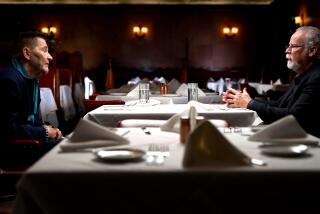Jury Visits Grotto Where Victim Died : Courts: Looming tree branches come together to form an enclosure that has dominated testimony about the murder of Kellie O’Sullivan.
- Share via
Moving outside the sterile confines of the courtroom, the jury hearing Mark Scott Thornton’s murder trial on Tuesday visited the grotto in the Santa Monica Mountains where slain Westlake nurse Kellie O’Sullivan’s body was found last year.
As the 20-year-old defendant stood close by, jurors got their first look at a shady spot that has dominated testimony during the first four weeks of the Thousand Oaks man’s trial.
Prosecutors had told jurors that Thornton forced O’Sullivan to her knees at the site on Sept. 14, 1993, and fired one bullet into her chest and two more into her back, killing her within minutes.
Several large, looming tree branches come together to form the cave-like grotto.
Jurors had to duck their heads to enter it, which they did one by one.
Once inside, they were allowed to walk around and look at a mannequin that had been placed on its front on the ground to represent the position in which the dead nurse was discovered.
Most of the jurors followed instructions, going into the grotto for about a half minute and heading back to the roadway without asking any questions.
But one juror, an elderly man in blue jeans and a white jacket, wanted more information about the use of the mannequin as he toured the area.
“Is this representative of how the body was found?” he asked, yelling to court officials who were assembled outside the clearing.
*
Superior Court Judge Charles R. McGrath, standing alongside some attorneys and other officials, declined to answer the question, reminding the man that jurors were only supposed to look at what was before them.
“Sorry,” said McGrath, who wore a shirt and tie but not his robe. “We can’t answer any questions.”
Prosecutors, who are seeking the death penalty for the young defendant, said the jury view is a crucial part of their case because it should erase any uncertainty and confusion jurors have about evidence from the murder scene.
“With an outdoor scene, jurors want to see it,” Deputy Dist. Atty. Peter D. Kossoris said, once the jurors piled back into two vans and headed for the courthouse. “I would want to see it, if I were a juror.”
Apparently, however, Thornton had no interest in seeing the murder site up close.
Sheriff’s officials had planned on taking the defendant to the grotto and letting him walk around it, if he so desired.
But Thornton never left the roadway after getting out of the sheriff’s cruiser that brought him to the mountains.
After the jury left, he simply got back into the police car and was returned to jail.
During his stay at the outdoor scene, about 20 minutes or so in all, the defendant mostly chatted with Deputy Public Defender Howard J. Asher, one of his attorneys.
At first, he gazed around and appeared to be in normal spirits.
But as the field trip dragged on, his mood seemed to grow more subdued.
He never shed any tears, as he had done in court two weeks ago when a picture of O’Sullivan’s decomposed body at the scene was shown.
But his jaw stiffened as he appeared to hold back some emotions.
Several times after he was arrested in Reno five days after O’Sullivan’s death, Thornton tried to escape from police officers, according to court testimony.
To ensure that did not happen Tuesday, sheriff’s officials assigned more than half a dozen deputies to guard him. They also had a police dog on the scene and made Thornton wear a leg restraint that limited his mobility.
Thornton’s legal camp declined to say why the defendant did not tour the grotto.
The grotto that jurors saw Tuesday looked different than it did on the day O’Sullivan was killed.
At the time of the murder, so much foliage hung in the grotto that no one could stand up inside it, prosecutors say, citing their theory that O’Sullivan had been kneeling when she was shot.
From Mulholland Drive, a pathway leads down a small hill to the crime site.
Vehicles can drive down that path and not be seen readily from the road above.
The only home visible from the site belongs to a woman who testified she heard three shots the day O’Sullivan was abducted.
Moments earlier, a motorist saw a man and woman fitting the descriptions of Thornton and O’Sullivan heading in the general direction of the mountains.
More to Read
Sign up for Essential California
The most important California stories and recommendations in your inbox every morning.
You may occasionally receive promotional content from the Los Angeles Times.












